International Comparison of Energy and Waste Sustainability: A Report
VerifiedAdded on 2022/12/16
|10
|2316
|303
Report
AI Summary
This report provides a comparative analysis of energy and waste sustainability practices in Australia and South Africa, fulfilling the requirements of a CVE80010 assignment. The report begins by outlining the actions taken by both countries regarding energy sustainability, including government regulations, renewable energy initiatives, and technological innovations. It then details the waste sustainability strategies employed, such as waste reduction policies, recycling programs, and the role of various stakeholders. The core of the report compares these actions, highlighting the differences in approaches and the impact of these strategies. Australia, as a developed country, is seen to have advanced technologies and policies for waste management and renewable energy, while South Africa, a developing country, is still in the process of implementing such measures. The report concludes by summarizing the key findings and emphasizing the importance of continuous innovation and stakeholder collaboration to achieve sustainable energy and waste management goals globally. References supporting the analysis are also included.
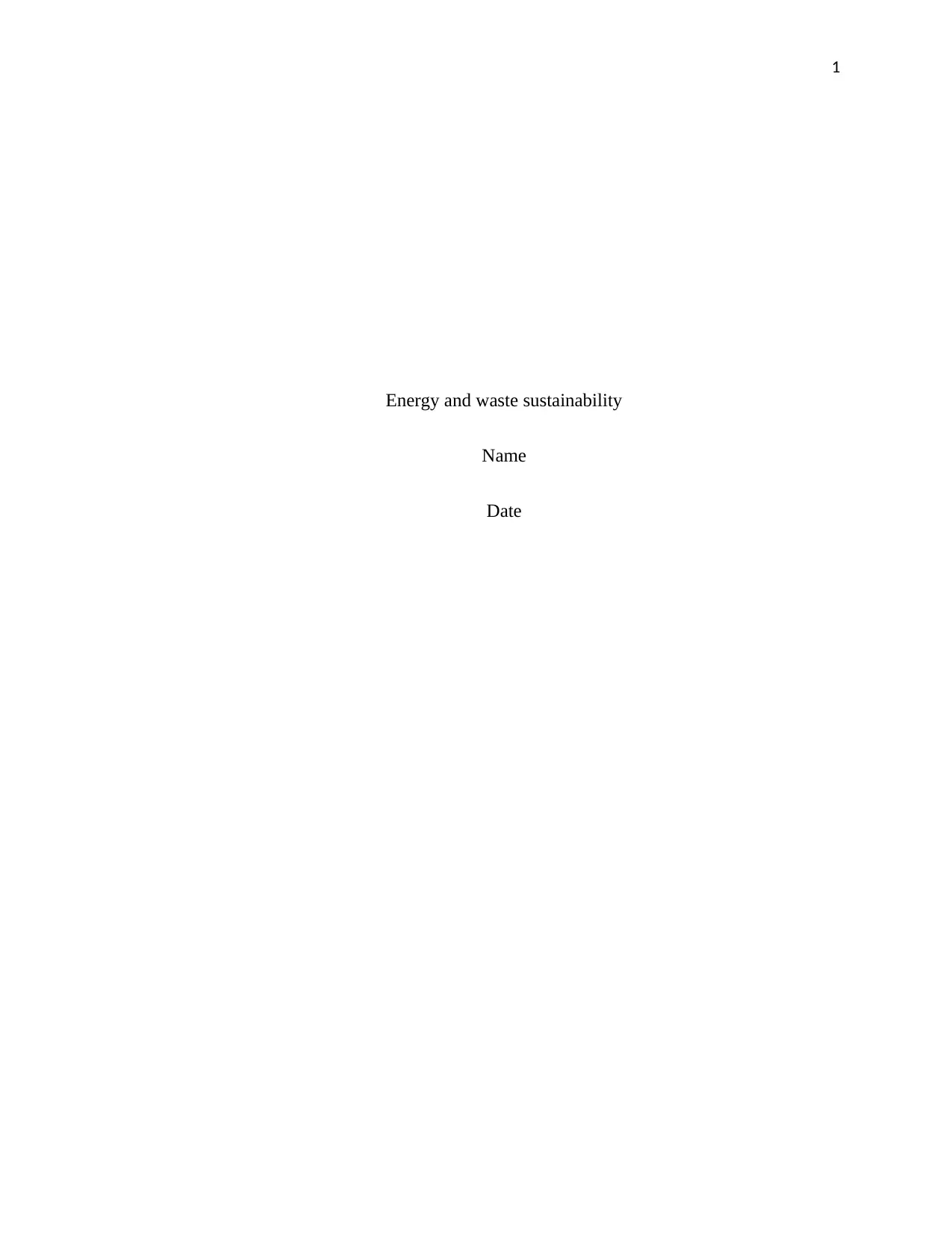
1
Energy and waste sustainability
Name
Date
Energy and waste sustainability
Name
Date
Paraphrase This Document
Need a fresh take? Get an instant paraphrase of this document with our AI Paraphraser
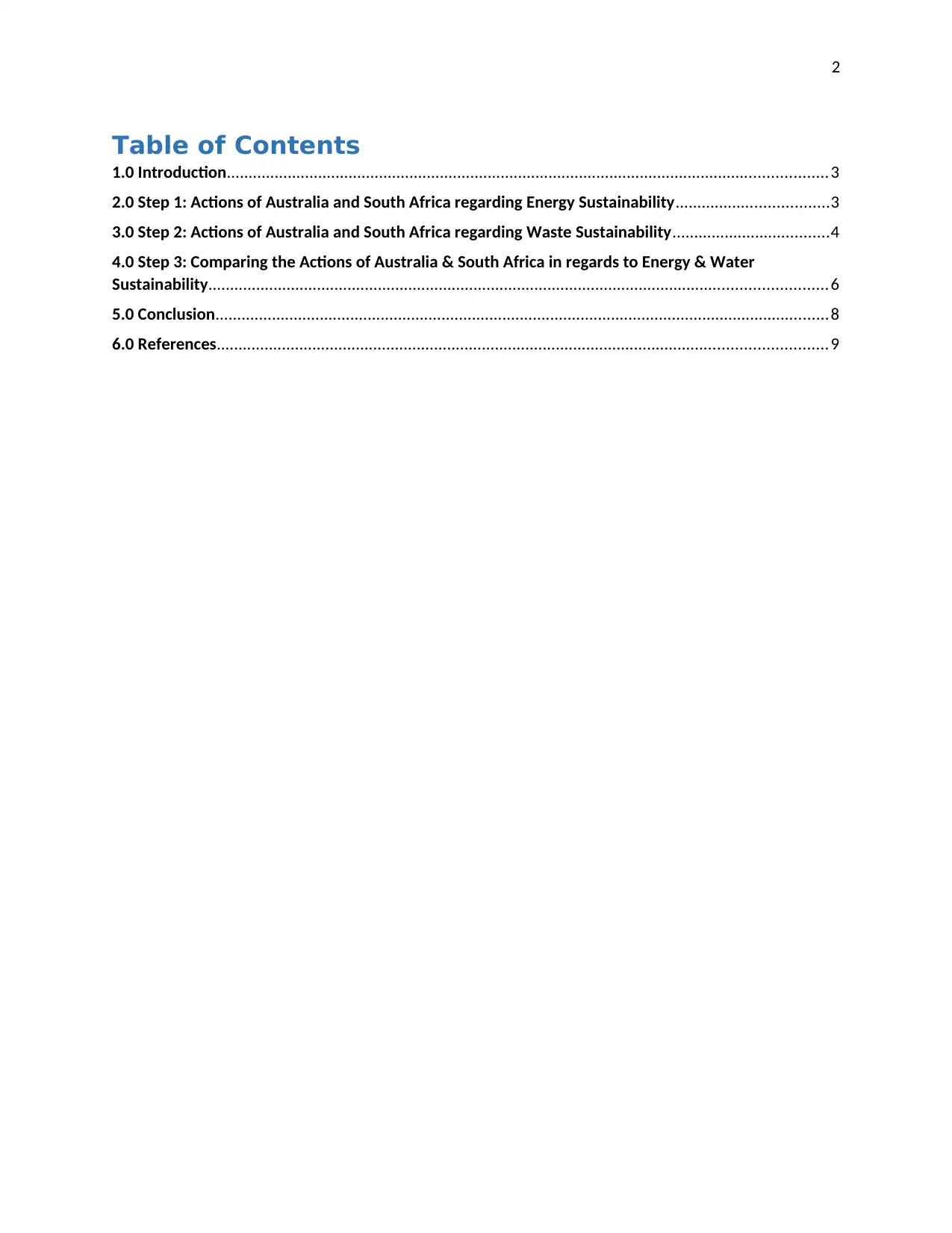
2
Table of Contents
1.0 Introduction..........................................................................................................................................3
2.0 Step 1: Actions of Australia and South Africa regarding Energy Sustainability...................................3
3.0 Step 2: Actions of Australia and South Africa regarding Waste Sustainability....................................4
4.0 Step 3: Comparing the Actions of Australia & South Africa in regards to Energy & Water
Sustainability..............................................................................................................................................6
5.0 Conclusion.............................................................................................................................................8
6.0 References............................................................................................................................................9
Table of Contents
1.0 Introduction..........................................................................................................................................3
2.0 Step 1: Actions of Australia and South Africa regarding Energy Sustainability...................................3
3.0 Step 2: Actions of Australia and South Africa regarding Waste Sustainability....................................4
4.0 Step 3: Comparing the Actions of Australia & South Africa in regards to Energy & Water
Sustainability..............................................................................................................................................6
5.0 Conclusion.............................................................................................................................................8
6.0 References............................................................................................................................................9
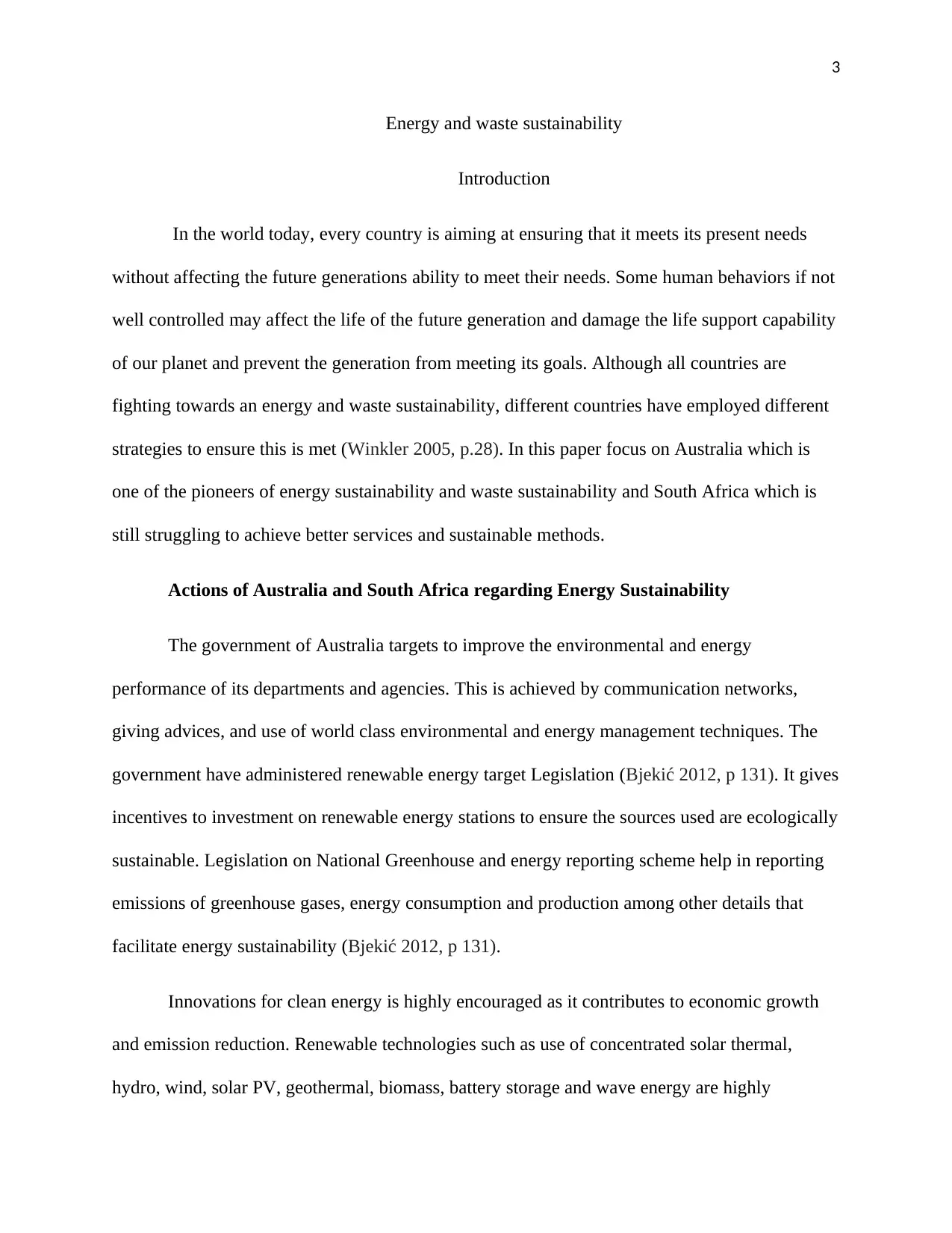
3
Energy and waste sustainability
Introduction
In the world today, every country is aiming at ensuring that it meets its present needs
without affecting the future generations ability to meet their needs. Some human behaviors if not
well controlled may affect the life of the future generation and damage the life support capability
of our planet and prevent the generation from meeting its goals. Although all countries are
fighting towards an energy and waste sustainability, different countries have employed different
strategies to ensure this is met (Winkler 2005, p.28). In this paper focus on Australia which is
one of the pioneers of energy sustainability and waste sustainability and South Africa which is
still struggling to achieve better services and sustainable methods.
Actions of Australia and South Africa regarding Energy Sustainability
The government of Australia targets to improve the environmental and energy
performance of its departments and agencies. This is achieved by communication networks,
giving advices, and use of world class environmental and energy management techniques. The
government have administered renewable energy target Legislation (Bjekić 2012, p 131). It gives
incentives to investment on renewable energy stations to ensure the sources used are ecologically
sustainable. Legislation on National Greenhouse and energy reporting scheme help in reporting
emissions of greenhouse gases, energy consumption and production among other details that
facilitate energy sustainability (Bjekić 2012, p 131).
Innovations for clean energy is highly encouraged as it contributes to economic growth
and emission reduction. Renewable technologies such as use of concentrated solar thermal,
hydro, wind, solar PV, geothermal, biomass, battery storage and wave energy are highly
Energy and waste sustainability
Introduction
In the world today, every country is aiming at ensuring that it meets its present needs
without affecting the future generations ability to meet their needs. Some human behaviors if not
well controlled may affect the life of the future generation and damage the life support capability
of our planet and prevent the generation from meeting its goals. Although all countries are
fighting towards an energy and waste sustainability, different countries have employed different
strategies to ensure this is met (Winkler 2005, p.28). In this paper focus on Australia which is
one of the pioneers of energy sustainability and waste sustainability and South Africa which is
still struggling to achieve better services and sustainable methods.
Actions of Australia and South Africa regarding Energy Sustainability
The government of Australia targets to improve the environmental and energy
performance of its departments and agencies. This is achieved by communication networks,
giving advices, and use of world class environmental and energy management techniques. The
government have administered renewable energy target Legislation (Bjekić 2012, p 131). It gives
incentives to investment on renewable energy stations to ensure the sources used are ecologically
sustainable. Legislation on National Greenhouse and energy reporting scheme help in reporting
emissions of greenhouse gases, energy consumption and production among other details that
facilitate energy sustainability (Bjekić 2012, p 131).
Innovations for clean energy is highly encouraged as it contributes to economic growth
and emission reduction. Renewable technologies such as use of concentrated solar thermal,
hydro, wind, solar PV, geothermal, biomass, battery storage and wave energy are highly
⊘ This is a preview!⊘
Do you want full access?
Subscribe today to unlock all pages.

Trusted by 1+ million students worldwide
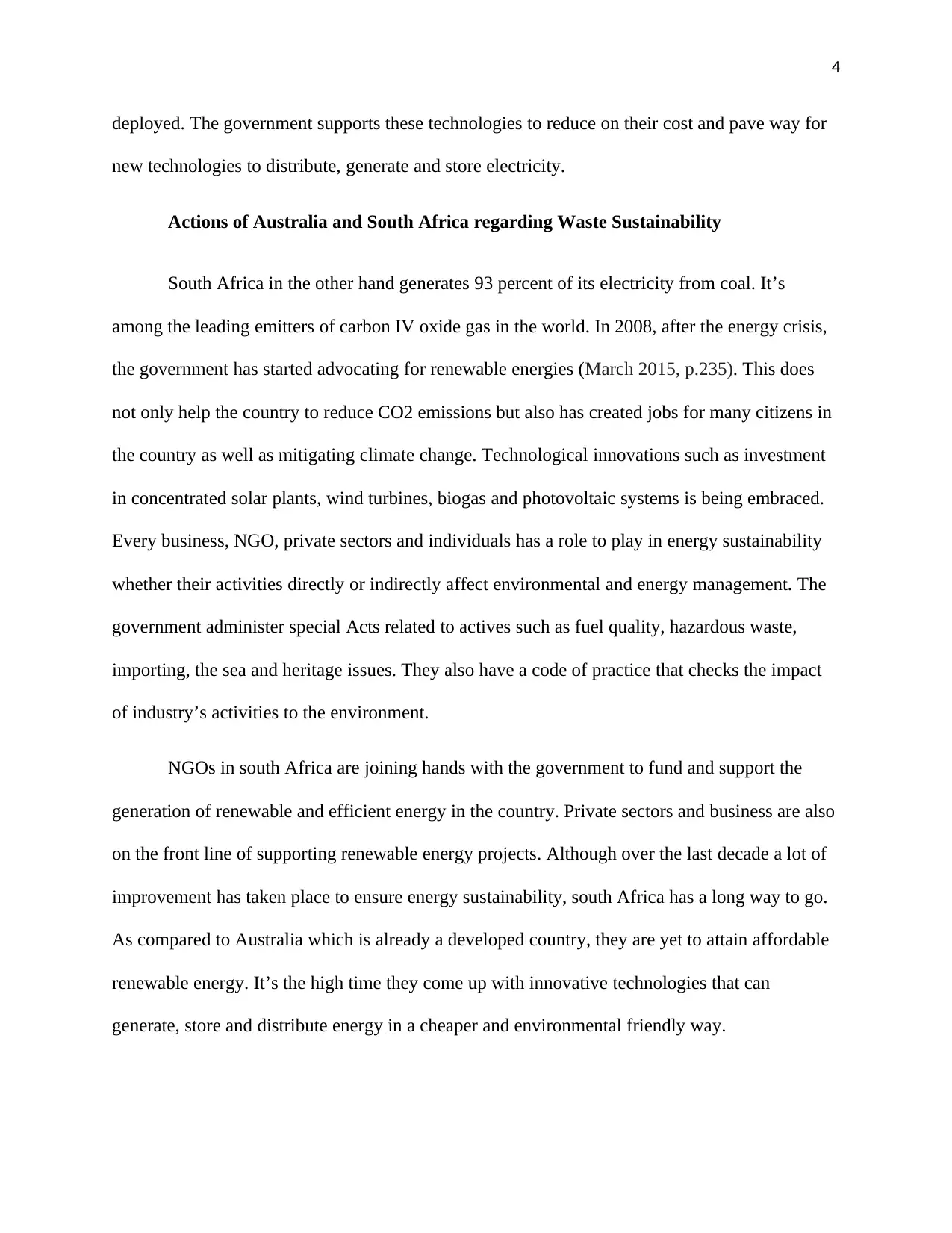
4
deployed. The government supports these technologies to reduce on their cost and pave way for
new technologies to distribute, generate and store electricity.
Actions of Australia and South Africa regarding Waste Sustainability
South Africa in the other hand generates 93 percent of its electricity from coal. It’s
among the leading emitters of carbon IV oxide gas in the world. In 2008, after the energy crisis,
the government has started advocating for renewable energies (March 2015, p.235). This does
not only help the country to reduce CO2 emissions but also has created jobs for many citizens in
the country as well as mitigating climate change. Technological innovations such as investment
in concentrated solar plants, wind turbines, biogas and photovoltaic systems is being embraced.
Every business, NGO, private sectors and individuals has a role to play in energy sustainability
whether their activities directly or indirectly affect environmental and energy management. The
government administer special Acts related to actives such as fuel quality, hazardous waste,
importing, the sea and heritage issues. They also have a code of practice that checks the impact
of industry’s activities to the environment.
NGOs in south Africa are joining hands with the government to fund and support the
generation of renewable and efficient energy in the country. Private sectors and business are also
on the front line of supporting renewable energy projects. Although over the last decade a lot of
improvement has taken place to ensure energy sustainability, south Africa has a long way to go.
As compared to Australia which is already a developed country, they are yet to attain affordable
renewable energy. It’s the high time they come up with innovative technologies that can
generate, store and distribute energy in a cheaper and environmental friendly way.
deployed. The government supports these technologies to reduce on their cost and pave way for
new technologies to distribute, generate and store electricity.
Actions of Australia and South Africa regarding Waste Sustainability
South Africa in the other hand generates 93 percent of its electricity from coal. It’s
among the leading emitters of carbon IV oxide gas in the world. In 2008, after the energy crisis,
the government has started advocating for renewable energies (March 2015, p.235). This does
not only help the country to reduce CO2 emissions but also has created jobs for many citizens in
the country as well as mitigating climate change. Technological innovations such as investment
in concentrated solar plants, wind turbines, biogas and photovoltaic systems is being embraced.
Every business, NGO, private sectors and individuals has a role to play in energy sustainability
whether their activities directly or indirectly affect environmental and energy management. The
government administer special Acts related to actives such as fuel quality, hazardous waste,
importing, the sea and heritage issues. They also have a code of practice that checks the impact
of industry’s activities to the environment.
NGOs in south Africa are joining hands with the government to fund and support the
generation of renewable and efficient energy in the country. Private sectors and business are also
on the front line of supporting renewable energy projects. Although over the last decade a lot of
improvement has taken place to ensure energy sustainability, south Africa has a long way to go.
As compared to Australia which is already a developed country, they are yet to attain affordable
renewable energy. It’s the high time they come up with innovative technologies that can
generate, store and distribute energy in a cheaper and environmental friendly way.
Paraphrase This Document
Need a fresh take? Get an instant paraphrase of this document with our AI Paraphraser
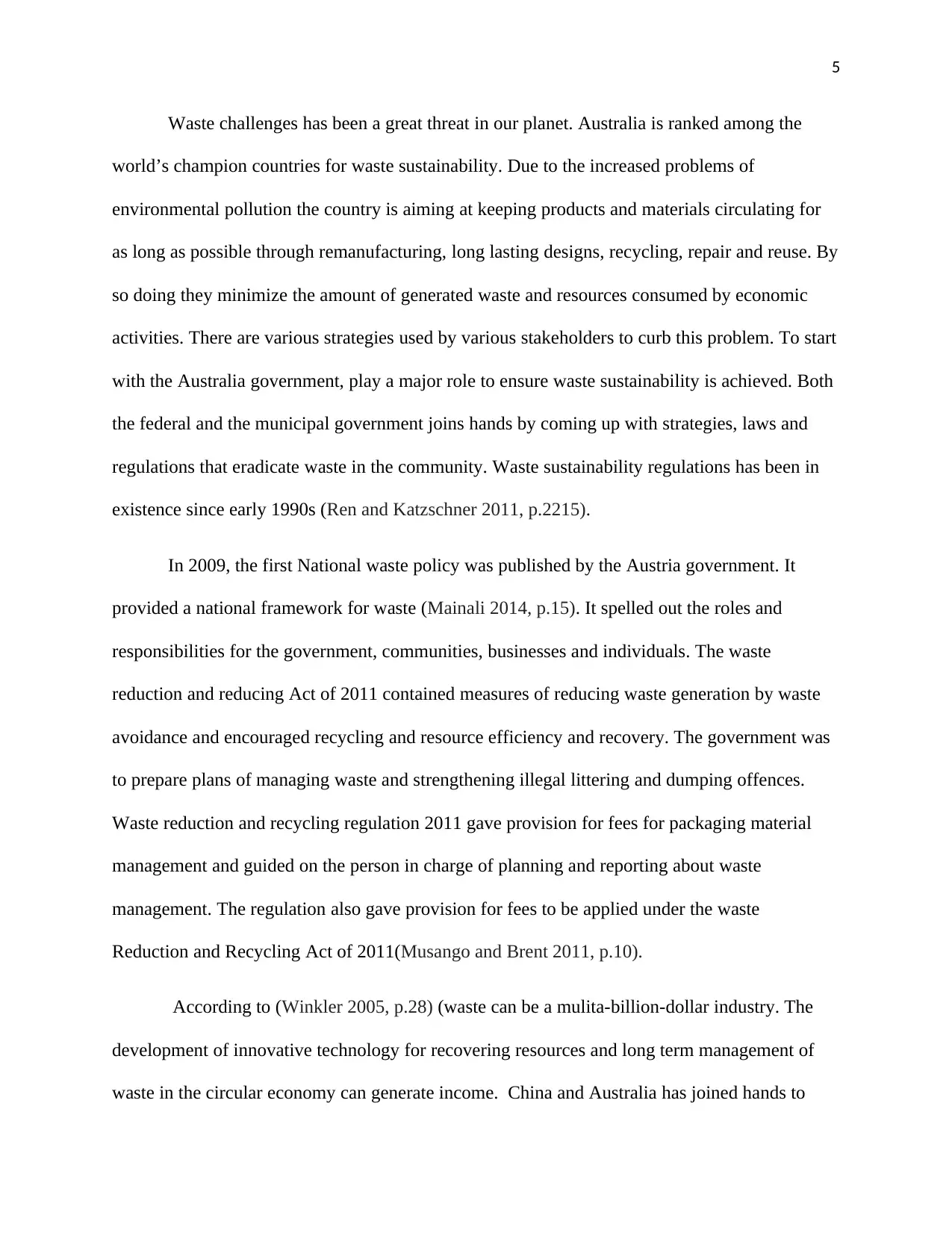
5
Waste challenges has been a great threat in our planet. Australia is ranked among the
world’s champion countries for waste sustainability. Due to the increased problems of
environmental pollution the country is aiming at keeping products and materials circulating for
as long as possible through remanufacturing, long lasting designs, recycling, repair and reuse. By
so doing they minimize the amount of generated waste and resources consumed by economic
activities. There are various strategies used by various stakeholders to curb this problem. To start
with the Australia government, play a major role to ensure waste sustainability is achieved. Both
the federal and the municipal government joins hands by coming up with strategies, laws and
regulations that eradicate waste in the community. Waste sustainability regulations has been in
existence since early 1990s (Ren and Katzschner 2011, p.2215).
In 2009, the first National waste policy was published by the Austria government. It
provided a national framework for waste (Mainali 2014, p.15). It spelled out the roles and
responsibilities for the government, communities, businesses and individuals. The waste
reduction and reducing Act of 2011 contained measures of reducing waste generation by waste
avoidance and encouraged recycling and resource efficiency and recovery. The government was
to prepare plans of managing waste and strengthening illegal littering and dumping offences.
Waste reduction and recycling regulation 2011 gave provision for fees for packaging material
management and guided on the person in charge of planning and reporting about waste
management. The regulation also gave provision for fees to be applied under the waste
Reduction and Recycling Act of 2011(Musango and Brent 2011, p.10).
According to (Winkler 2005, p.28) (waste can be a mulita-billion-dollar industry. The
development of innovative technology for recovering resources and long term management of
waste in the circular economy can generate income. China and Australia has joined hands to
Waste challenges has been a great threat in our planet. Australia is ranked among the
world’s champion countries for waste sustainability. Due to the increased problems of
environmental pollution the country is aiming at keeping products and materials circulating for
as long as possible through remanufacturing, long lasting designs, recycling, repair and reuse. By
so doing they minimize the amount of generated waste and resources consumed by economic
activities. There are various strategies used by various stakeholders to curb this problem. To start
with the Australia government, play a major role to ensure waste sustainability is achieved. Both
the federal and the municipal government joins hands by coming up with strategies, laws and
regulations that eradicate waste in the community. Waste sustainability regulations has been in
existence since early 1990s (Ren and Katzschner 2011, p.2215).
In 2009, the first National waste policy was published by the Austria government. It
provided a national framework for waste (Mainali 2014, p.15). It spelled out the roles and
responsibilities for the government, communities, businesses and individuals. The waste
reduction and reducing Act of 2011 contained measures of reducing waste generation by waste
avoidance and encouraged recycling and resource efficiency and recovery. The government was
to prepare plans of managing waste and strengthening illegal littering and dumping offences.
Waste reduction and recycling regulation 2011 gave provision for fees for packaging material
management and guided on the person in charge of planning and reporting about waste
management. The regulation also gave provision for fees to be applied under the waste
Reduction and Recycling Act of 2011(Musango and Brent 2011, p.10).
According to (Winkler 2005, p.28) (waste can be a mulita-billion-dollar industry. The
development of innovative technology for recovering resources and long term management of
waste in the circular economy can generate income. China and Australia has joined hands to
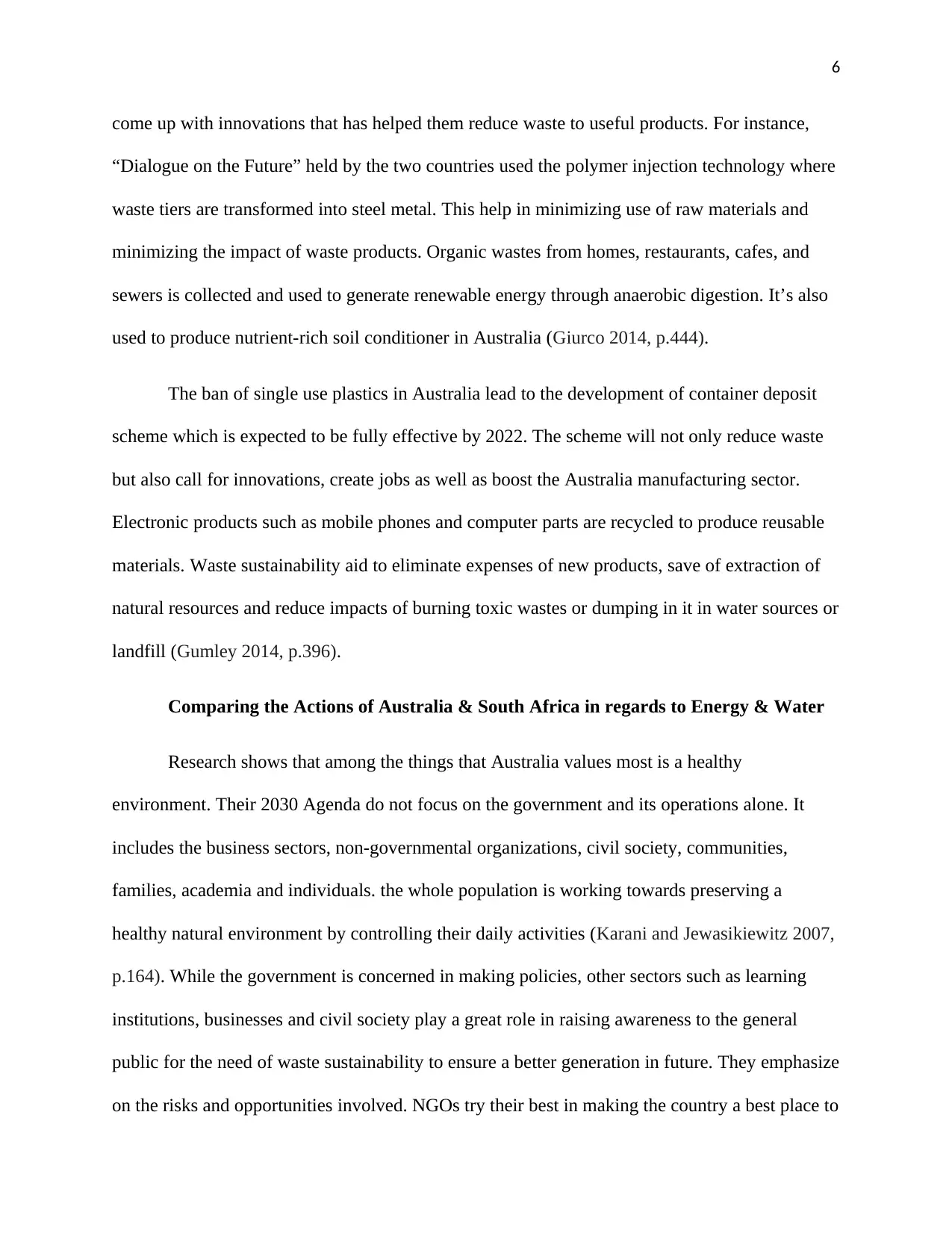
6
come up with innovations that has helped them reduce waste to useful products. For instance,
“Dialogue on the Future” held by the two countries used the polymer injection technology where
waste tiers are transformed into steel metal. This help in minimizing use of raw materials and
minimizing the impact of waste products. Organic wastes from homes, restaurants, cafes, and
sewers is collected and used to generate renewable energy through anaerobic digestion. It’s also
used to produce nutrient-rich soil conditioner in Australia (Giurco 2014, p.444).
The ban of single use plastics in Australia lead to the development of container deposit
scheme which is expected to be fully effective by 2022. The scheme will not only reduce waste
but also call for innovations, create jobs as well as boost the Australia manufacturing sector.
Electronic products such as mobile phones and computer parts are recycled to produce reusable
materials. Waste sustainability aid to eliminate expenses of new products, save of extraction of
natural resources and reduce impacts of burning toxic wastes or dumping in it in water sources or
landfill (Gumley 2014, p.396).
Comparing the Actions of Australia & South Africa in regards to Energy & Water
Research shows that among the things that Australia values most is a healthy
environment. Their 2030 Agenda do not focus on the government and its operations alone. It
includes the business sectors, non-governmental organizations, civil society, communities,
families, academia and individuals. the whole population is working towards preserving a
healthy natural environment by controlling their daily activities (Karani and Jewasikiewitz 2007,
p.164). While the government is concerned in making policies, other sectors such as learning
institutions, businesses and civil society play a great role in raising awareness to the general
public for the need of waste sustainability to ensure a better generation in future. They emphasize
on the risks and opportunities involved. NGOs try their best in making the country a best place to
come up with innovations that has helped them reduce waste to useful products. For instance,
“Dialogue on the Future” held by the two countries used the polymer injection technology where
waste tiers are transformed into steel metal. This help in minimizing use of raw materials and
minimizing the impact of waste products. Organic wastes from homes, restaurants, cafes, and
sewers is collected and used to generate renewable energy through anaerobic digestion. It’s also
used to produce nutrient-rich soil conditioner in Australia (Giurco 2014, p.444).
The ban of single use plastics in Australia lead to the development of container deposit
scheme which is expected to be fully effective by 2022. The scheme will not only reduce waste
but also call for innovations, create jobs as well as boost the Australia manufacturing sector.
Electronic products such as mobile phones and computer parts are recycled to produce reusable
materials. Waste sustainability aid to eliminate expenses of new products, save of extraction of
natural resources and reduce impacts of burning toxic wastes or dumping in it in water sources or
landfill (Gumley 2014, p.396).
Comparing the Actions of Australia & South Africa in regards to Energy & Water
Research shows that among the things that Australia values most is a healthy
environment. Their 2030 Agenda do not focus on the government and its operations alone. It
includes the business sectors, non-governmental organizations, civil society, communities,
families, academia and individuals. the whole population is working towards preserving a
healthy natural environment by controlling their daily activities (Karani and Jewasikiewitz 2007,
p.164). While the government is concerned in making policies, other sectors such as learning
institutions, businesses and civil society play a great role in raising awareness to the general
public for the need of waste sustainability to ensure a better generation in future. They emphasize
on the risks and opportunities involved. NGOs try their best in making the country a best place to
⊘ This is a preview!⊘
Do you want full access?
Subscribe today to unlock all pages.

Trusted by 1+ million students worldwide
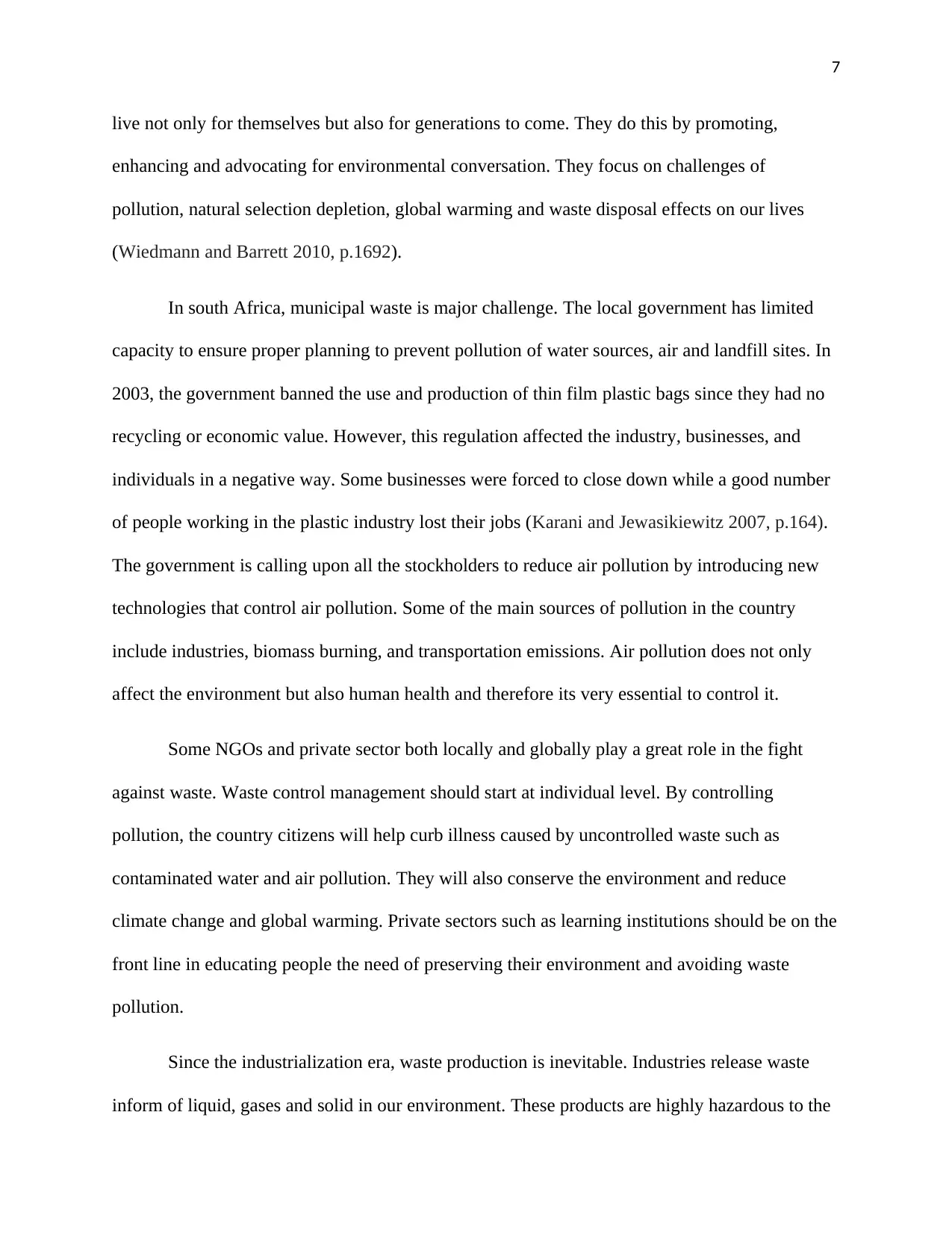
7
live not only for themselves but also for generations to come. They do this by promoting,
enhancing and advocating for environmental conversation. They focus on challenges of
pollution, natural selection depletion, global warming and waste disposal effects on our lives
(Wiedmann and Barrett 2010, p.1692).
In south Africa, municipal waste is major challenge. The local government has limited
capacity to ensure proper planning to prevent pollution of water sources, air and landfill sites. In
2003, the government banned the use and production of thin film plastic bags since they had no
recycling or economic value. However, this regulation affected the industry, businesses, and
individuals in a negative way. Some businesses were forced to close down while a good number
of people working in the plastic industry lost their jobs (Karani and Jewasikiewitz 2007, p.164).
The government is calling upon all the stockholders to reduce air pollution by introducing new
technologies that control air pollution. Some of the main sources of pollution in the country
include industries, biomass burning, and transportation emissions. Air pollution does not only
affect the environment but also human health and therefore its very essential to control it.
Some NGOs and private sector both locally and globally play a great role in the fight
against waste. Waste control management should start at individual level. By controlling
pollution, the country citizens will help curb illness caused by uncontrolled waste such as
contaminated water and air pollution. They will also conserve the environment and reduce
climate change and global warming. Private sectors such as learning institutions should be on the
front line in educating people the need of preserving their environment and avoiding waste
pollution.
Since the industrialization era, waste production is inevitable. Industries release waste
inform of liquid, gases and solid in our environment. These products are highly hazardous to the
live not only for themselves but also for generations to come. They do this by promoting,
enhancing and advocating for environmental conversation. They focus on challenges of
pollution, natural selection depletion, global warming and waste disposal effects on our lives
(Wiedmann and Barrett 2010, p.1692).
In south Africa, municipal waste is major challenge. The local government has limited
capacity to ensure proper planning to prevent pollution of water sources, air and landfill sites. In
2003, the government banned the use and production of thin film plastic bags since they had no
recycling or economic value. However, this regulation affected the industry, businesses, and
individuals in a negative way. Some businesses were forced to close down while a good number
of people working in the plastic industry lost their jobs (Karani and Jewasikiewitz 2007, p.164).
The government is calling upon all the stockholders to reduce air pollution by introducing new
technologies that control air pollution. Some of the main sources of pollution in the country
include industries, biomass burning, and transportation emissions. Air pollution does not only
affect the environment but also human health and therefore its very essential to control it.
Some NGOs and private sector both locally and globally play a great role in the fight
against waste. Waste control management should start at individual level. By controlling
pollution, the country citizens will help curb illness caused by uncontrolled waste such as
contaminated water and air pollution. They will also conserve the environment and reduce
climate change and global warming. Private sectors such as learning institutions should be on the
front line in educating people the need of preserving their environment and avoiding waste
pollution.
Since the industrialization era, waste production is inevitable. Industries release waste
inform of liquid, gases and solid in our environment. These products are highly hazardous to the
Paraphrase This Document
Need a fresh take? Get an instant paraphrase of this document with our AI Paraphraser
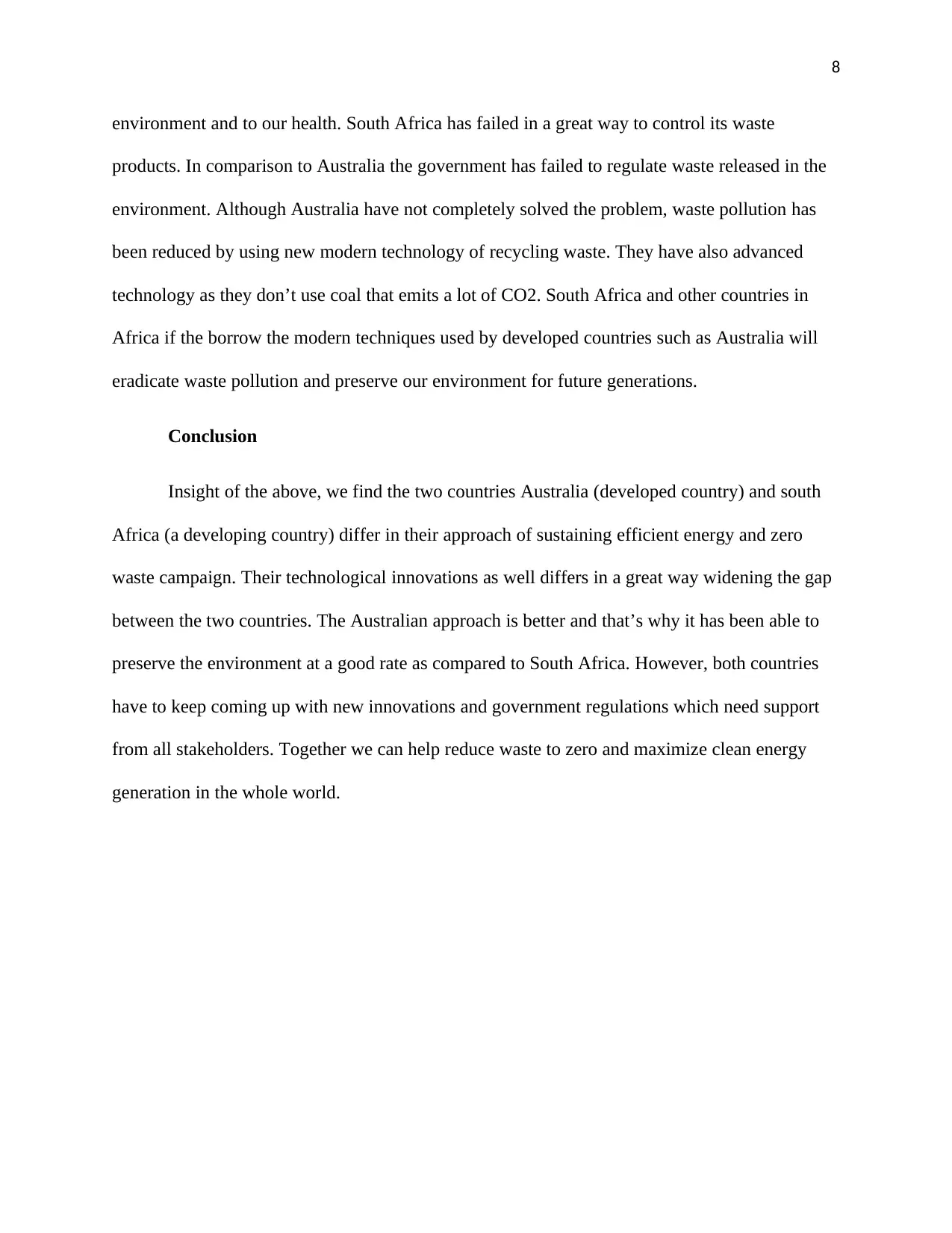
8
environment and to our health. South Africa has failed in a great way to control its waste
products. In comparison to Australia the government has failed to regulate waste released in the
environment. Although Australia have not completely solved the problem, waste pollution has
been reduced by using new modern technology of recycling waste. They have also advanced
technology as they don’t use coal that emits a lot of CO2. South Africa and other countries in
Africa if the borrow the modern techniques used by developed countries such as Australia will
eradicate waste pollution and preserve our environment for future generations.
Conclusion
Insight of the above, we find the two countries Australia (developed country) and south
Africa (a developing country) differ in their approach of sustaining efficient energy and zero
waste campaign. Their technological innovations as well differs in a great way widening the gap
between the two countries. The Australian approach is better and that’s why it has been able to
preserve the environment at a good rate as compared to South Africa. However, both countries
have to keep coming up with new innovations and government regulations which need support
from all stakeholders. Together we can help reduce waste to zero and maximize clean energy
generation in the whole world.
environment and to our health. South Africa has failed in a great way to control its waste
products. In comparison to Australia the government has failed to regulate waste released in the
environment. Although Australia have not completely solved the problem, waste pollution has
been reduced by using new modern technology of recycling waste. They have also advanced
technology as they don’t use coal that emits a lot of CO2. South Africa and other countries in
Africa if the borrow the modern techniques used by developed countries such as Australia will
eradicate waste pollution and preserve our environment for future generations.
Conclusion
Insight of the above, we find the two countries Australia (developed country) and south
Africa (a developing country) differ in their approach of sustaining efficient energy and zero
waste campaign. Their technological innovations as well differs in a great way widening the gap
between the two countries. The Australian approach is better and that’s why it has been able to
preserve the environment at a good rate as compared to South Africa. However, both countries
have to keep coming up with new innovations and government regulations which need support
from all stakeholders. Together we can help reduce waste to zero and maximize clean energy
generation in the whole world.
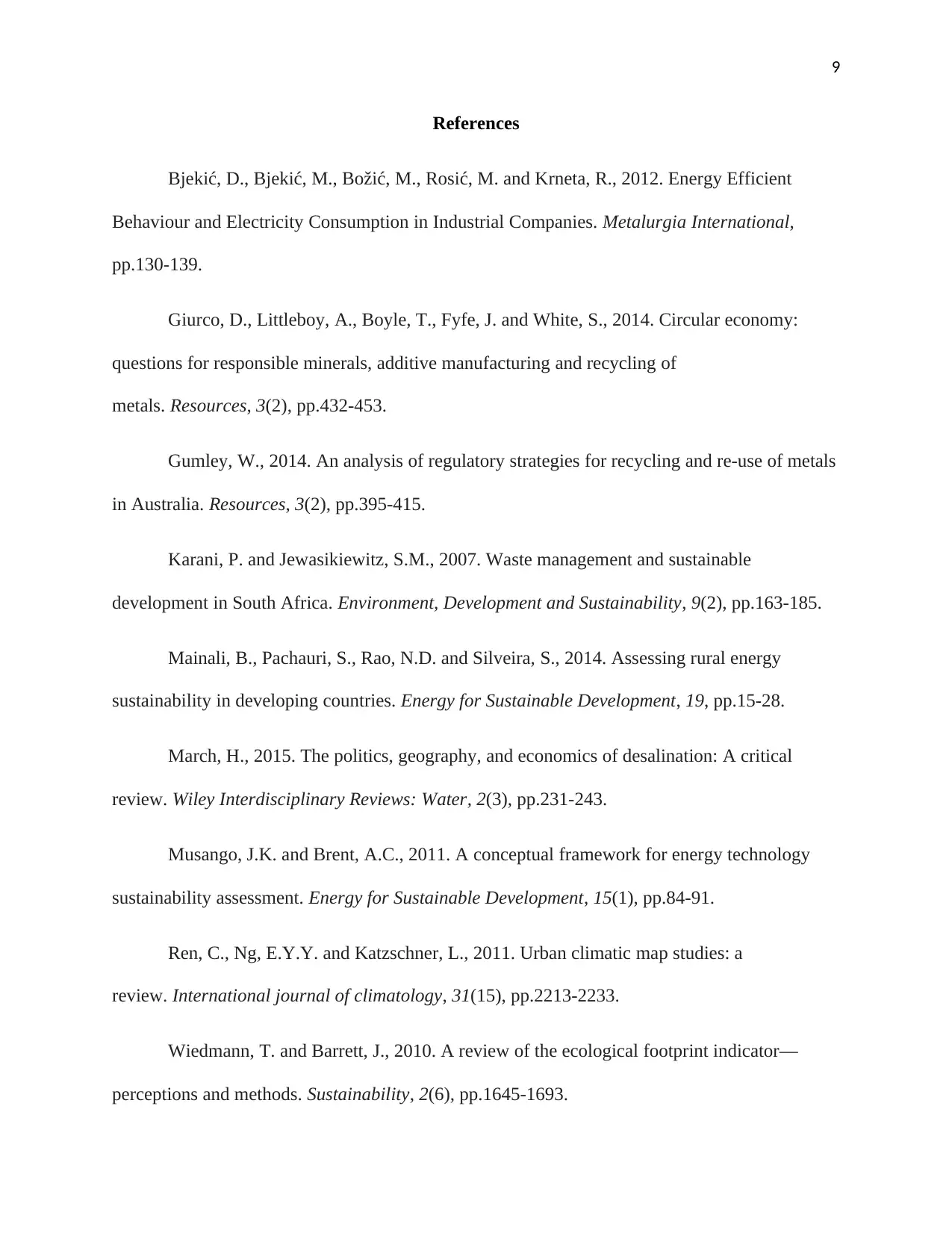
9
References
Bjekić, D., Bjekić, M., Božić, M., Rosić, M. and Krneta, R., 2012. Energy Efficient
Behaviour and Electricity Consumption in Industrial Companies. Metalurgia International,
pp.130-139.
Giurco, D., Littleboy, A., Boyle, T., Fyfe, J. and White, S., 2014. Circular economy:
questions for responsible minerals, additive manufacturing and recycling of
metals. Resources, 3(2), pp.432-453.
Gumley, W., 2014. An analysis of regulatory strategies for recycling and re-use of metals
in Australia. Resources, 3(2), pp.395-415.
Karani, P. and Jewasikiewitz, S.M., 2007. Waste management and sustainable
development in South Africa. Environment, Development and Sustainability, 9(2), pp.163-185.
Mainali, B., Pachauri, S., Rao, N.D. and Silveira, S., 2014. Assessing rural energy
sustainability in developing countries. Energy for Sustainable Development, 19, pp.15-28.
March, H., 2015. The politics, geography, and economics of desalination: A critical
review. Wiley Interdisciplinary Reviews: Water, 2(3), pp.231-243.
Musango, J.K. and Brent, A.C., 2011. A conceptual framework for energy technology
sustainability assessment. Energy for Sustainable Development, 15(1), pp.84-91.
Ren, C., Ng, E.Y.Y. and Katzschner, L., 2011. Urban climatic map studies: a
review. International journal of climatology, 31(15), pp.2213-2233.
Wiedmann, T. and Barrett, J., 2010. A review of the ecological footprint indicator—
perceptions and methods. Sustainability, 2(6), pp.1645-1693.
References
Bjekić, D., Bjekić, M., Božić, M., Rosić, M. and Krneta, R., 2012. Energy Efficient
Behaviour and Electricity Consumption in Industrial Companies. Metalurgia International,
pp.130-139.
Giurco, D., Littleboy, A., Boyle, T., Fyfe, J. and White, S., 2014. Circular economy:
questions for responsible minerals, additive manufacturing and recycling of
metals. Resources, 3(2), pp.432-453.
Gumley, W., 2014. An analysis of regulatory strategies for recycling and re-use of metals
in Australia. Resources, 3(2), pp.395-415.
Karani, P. and Jewasikiewitz, S.M., 2007. Waste management and sustainable
development in South Africa. Environment, Development and Sustainability, 9(2), pp.163-185.
Mainali, B., Pachauri, S., Rao, N.D. and Silveira, S., 2014. Assessing rural energy
sustainability in developing countries. Energy for Sustainable Development, 19, pp.15-28.
March, H., 2015. The politics, geography, and economics of desalination: A critical
review. Wiley Interdisciplinary Reviews: Water, 2(3), pp.231-243.
Musango, J.K. and Brent, A.C., 2011. A conceptual framework for energy technology
sustainability assessment. Energy for Sustainable Development, 15(1), pp.84-91.
Ren, C., Ng, E.Y.Y. and Katzschner, L., 2011. Urban climatic map studies: a
review. International journal of climatology, 31(15), pp.2213-2233.
Wiedmann, T. and Barrett, J., 2010. A review of the ecological footprint indicator—
perceptions and methods. Sustainability, 2(6), pp.1645-1693.
⊘ This is a preview!⊘
Do you want full access?
Subscribe today to unlock all pages.

Trusted by 1+ million students worldwide
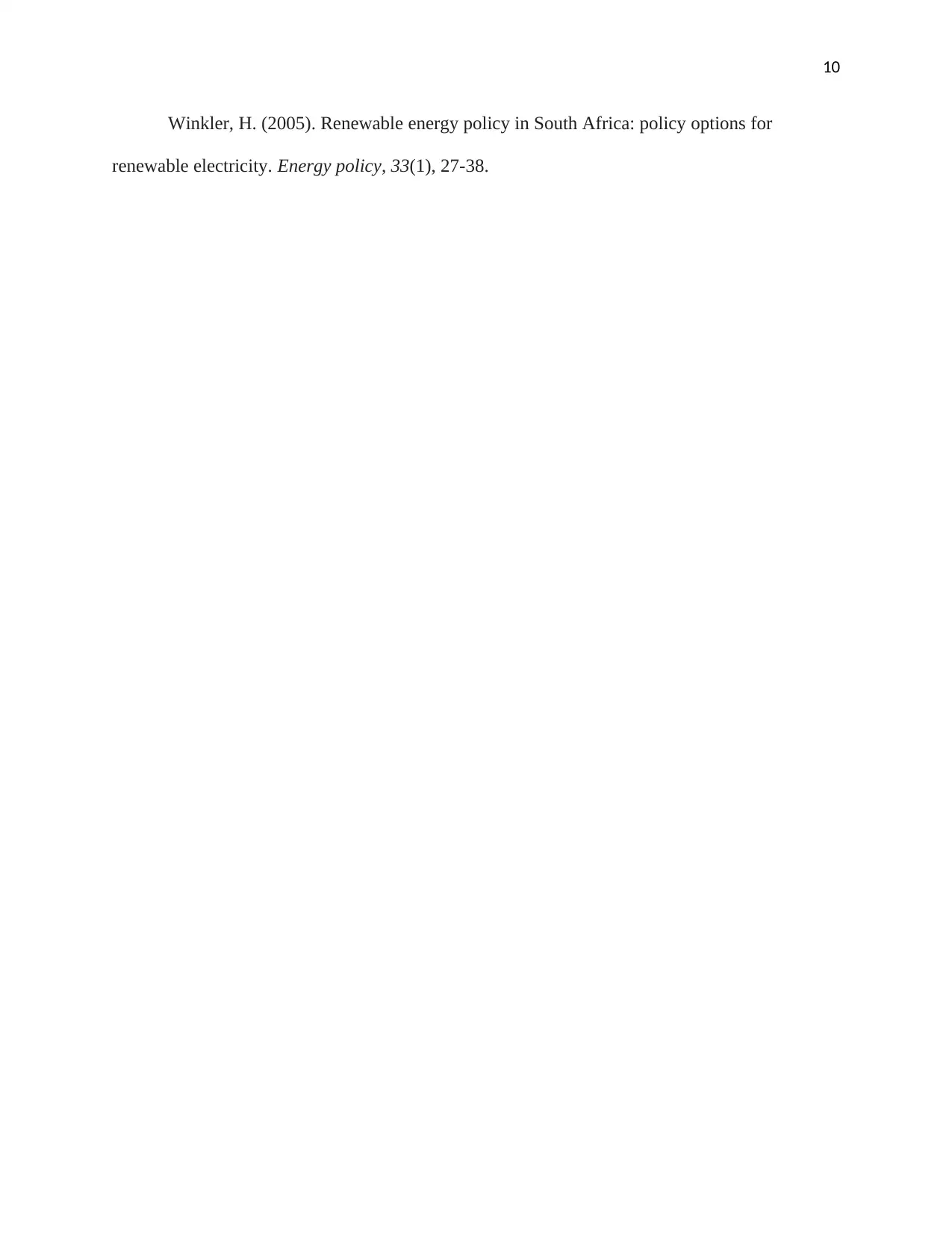
10
Winkler, H. (2005). Renewable energy policy in South Africa: policy options for
renewable electricity. Energy policy, 33(1), 27-38.
Winkler, H. (2005). Renewable energy policy in South Africa: policy options for
renewable electricity. Energy policy, 33(1), 27-38.
1 out of 10
Related Documents
Your All-in-One AI-Powered Toolkit for Academic Success.
+13062052269
info@desklib.com
Available 24*7 on WhatsApp / Email
![[object Object]](/_next/static/media/star-bottom.7253800d.svg)
Unlock your academic potential
Copyright © 2020–2025 A2Z Services. All Rights Reserved. Developed and managed by ZUCOL.





